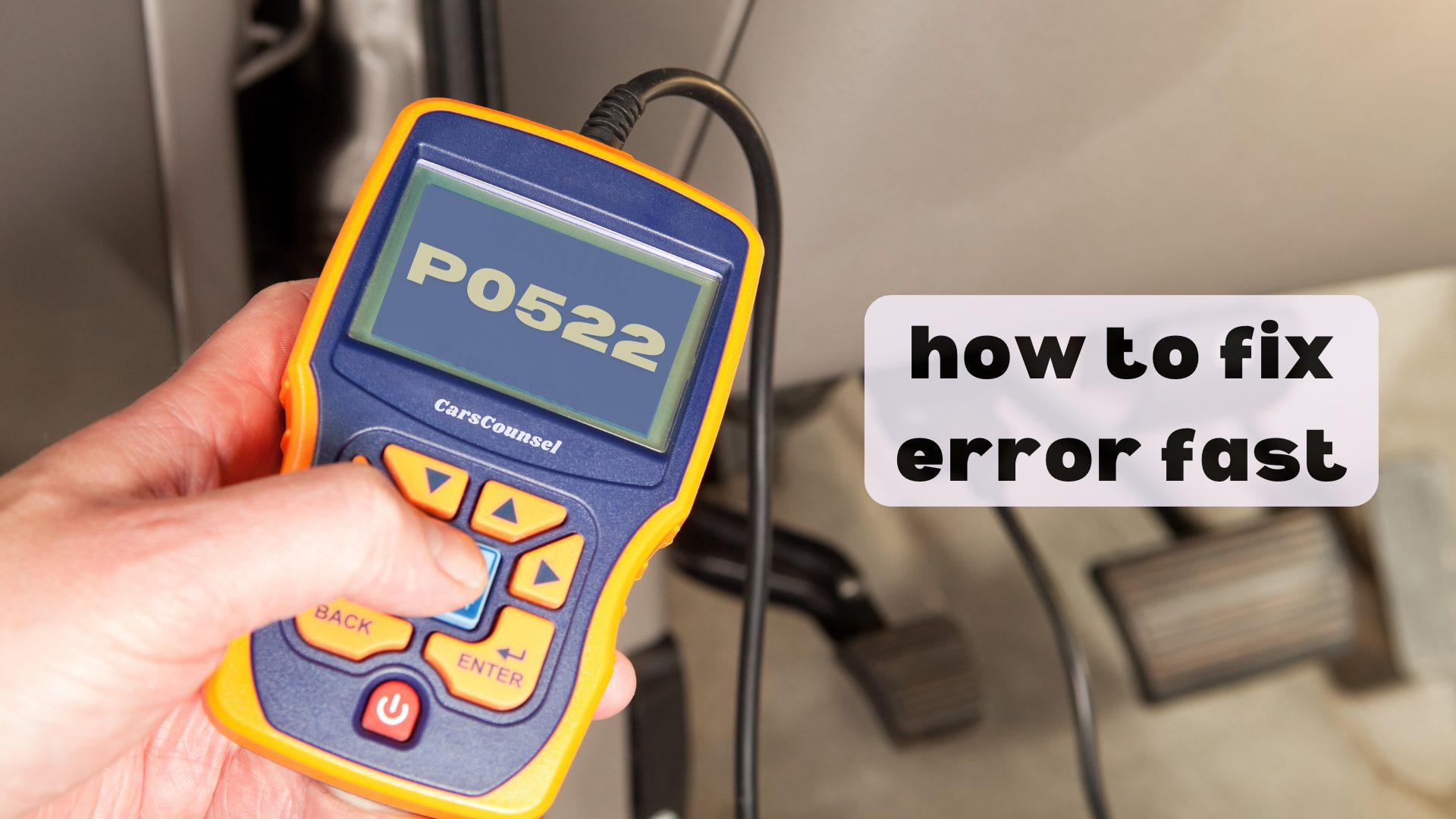When dealing with the P0522 code, start by checking if your engine oil level is correct. Low oil can trigger this error, so adding oil might solve the problem quickly.
However, don’t stop there—look at the oil pressure sensor for any damage and check the wiring for loose connections or rust.
Using an OBD-II scanner will let you know it is part of a larger OBD2 Codes list and can help you identify the issue more accurately.
Knowing these steps is important, but there’s more to learn to fully fix this error and prevent it from happening again.

Quick Navigation
Key Takeaways
- Check the engine oil level and add more if it’s low.
- Replace the bad oil pressure sensor to get accurate readings again.
- Look for and fix any damaged or corroded wires connected to the oil pressure sensor.
- Change the engine oil and oil filter to make sure the engine is well-lubricated and the sensor works right.
Importance of P0522 Code
The P0522 code is important because it serves as an early warning for potential engine oil pressure issues. By catching these problems early, you can fix them before they lead to serious engine damage.
This code helps keep your engine running smoothly by alerting you to any oil pressure discrepancies. Ignoring it can result in major problems like engine overheating or even engine failure.
Regularly checking your engine’s oil pressure is crucial since it impacts both lubrication and cooling. When the P0522 code triggers the check engine light, it needs immediate attention.
Understanding and quickly responding to this alert can extend your engine’s life and save you from expensive repairs. Always take oil pressure warnings seriously to keep your engine in good shape.
Meaning of P0522 Code
Understanding what the P0522 code means is important for diagnosing and fixing oil pressure problems. The P0522 code is a trouble code that shows there’s something wrong with the oil pressure sensor. This sensor is crucial because it sends oil pressure information to the engine control module (ECM). If the sensor isn’t working right, it can give incorrect readings, which might mess with the engine’s performance, causing things like misfires or making it hard to start the engine. Keeping the oil pressure just right is key for the engine’s health.
| Component | Role |
|---|---|
| Oil Pressure Sensor | Measures and reports oil pressure to ECM |
| Engine Control Module (ECM) | Receives and processes oil pressure data |
| Diagnostic Trouble Code | Indicates sensor malfunction (P0522) |
Understanding this helps you make timely and effective repairs.
Causes of P0522 Code
Causes of P0522 Code
Several factors can lead to a P0522 code, and identifying these causes is crucial for effective troubleshooting and repair. Here are the possibilities you should consider:
- Faulty Engine Oil Pressure Sensor: This sensor can wear out or get dirty, causing it to fail.
- Wiring Issues: Check for damaged or loose wires, which can mess up the sensor’s signal.
- Low Oil Pressure: Not enough oil pressure can trigger this code and harm your engine.
Addressing these causes ensures an accurate diagnosis and helps prevent further engine problems.
Always start with the simplest checks before moving on to more complicated repairs.
Symptoms of P0522 Code
A common sign of a P0522 code is the check engine light coming on. This usually means there’s a problem with the oil pressure sensor. If this sensor isn’t working right, it sends wrong information to the engine control module (ECM), which can cause various issues.
You might see strange oil pressure readings or no oil pressure reading at all. The engine might also have trouble running smoothly, like rough idling or difficulty starting.
Low oil pressure can also make the engine noisy, with sounds like knocking or ticking because of increased friction from lack of lubrication. It’s important to fix these problems quickly to avoid more engine damage.
Check Engine Oil
First, make sure you check the engine oil level and quality to rule out any basic maintenance issues. The right oil thickness is important for keeping good oil pressure and ensuring your engine lasts a long time.
Start by:
- Checking the oil level: Make sure it’s within the recommended range on the dipstick.
- Looking at the oil color and feel: If it’s dark and gritty, it’s time for a change.
- Smelling the oil: A burnt smell could mean overheating or other problems.
These steps help you spot potential issues that might be causing the P0522 code.
Keeping the right oil thickness and quality is key to preventing engine damage and ensuring smooth operation.
Test Oil Pressure Sensor
To test the oil pressure sensor, you’ll need a multimeter to check its continuity and resistance. First, disconnect the sensor’s electrical connector.
Set your multimeter to the resistance (ohms) setting. Then, place the multimeter probes on the sensor terminals and check the reading. You should get a specific resistance value—check your vehicle’s manual for the exact number. If the resistance isn’t within the specified range, the sensor might be faulty.
For continuity testing, make sure there’s a continuous path without much resistance. Follow these steps to ensure the sensor is working properly. A bad sensor can give wrong data, which can cause the P0522 error code to appear.
Accurate sensor readings are important for your engine to run smoothly and stay in good health.
Inspect Wiring
Check the Wiring
When diagnosing a P0522 code, carefully check the wiring connected to the engine oil pressure sensor for any damage or disconnection. Use wiring diagrams to trace and verify each sensor connection.
Pay attention to:
- Worn Wires: Look for any wear or tears in the insulation.
- Rusty Connectors: Check connectors for rust or corrosion that could affect signal transmission.
- Loose Connections: Make sure all connections are tight and secure.
Evaluate Oil Pump
Checking if the oil pump is working properly is important to make sure it’s not causing the low oil pressure shown by the P0522 code.
Start by looking for any blockages or damage in the oil pump. Make sure it’s pumping oil well; if it’s not, it could cause the P0522 code.
Regularly check the oil pump for any signs of wear or damage. Use a pressure gauge to measure the oil pressure directly; if the readings are lower than what the manufacturer says they should be, the oil pump might be the problem.
Fix any issues right away to avoid more engine damage. Proper checks and maintenance of the oil pump will help keep the oil pressure at the right level, ensuring your engine lasts longer.
Replace Oil Pressure Sensor
Changing the oil pressure sensor involves a few straightforward steps. First, disconnect the battery to ensure safety.
Then, find where the faulty sensor is located in your vehicle. Gently unplug the sensor’s electrical connector. Use a socket wrench to remove the old sensor, making sure no dirt or debris gets into the opening.
When putting in the new sensor, keep these tips in mind:
- Use thread sealant: This helps prevent oil leaks.
- Torque correctly: Tighten the sensor according to the manufacturer’s instructions.
- Reconnect the wiring: Make sure the connections are secure.
Installing the sensor correctly is crucial for getting accurate oil pressure readings. By following these steps, you can replace the oil pressure sensor and fix the P0522 code.
Routine Maintenance
After putting in a new oil pressure sensor, it’s important to keep up with regular maintenance to avoid future engine problems.
Change your oil regularly since fresh oil helps with proper lubrication and accurate sensor readings. Don’t forget to replace the oil filter too; a clean filter catches contaminants and protects both the sensor and the engine.
Follow the service schedule recommended by your vehicle manufacturer. This includes not only changing the oil and filter but also checking other parts like the oil pump from time to time.
Regular maintenance reduces the risk of low oil pressure and potential engine damage. By staying on top of these tasks, you help ensure your vehicle’s engine lasts longer and runs smoothly.
More OBD-II Codes
Frequently Asked Questions
Can Driving With a P0522 Code Damage My Engine?
Yes, driving with a P0522 code can harm your engine. Low oil pressure may cause your engine to not run well and could lead to serious damage. Check the oil pressure and sensor right away to prevent any problems.
How Much Does It Cost to Fix a P0522 Code?
If you need to fix a P0522 code, you might be looking at about $150 for a new oil pressure sensor and around $100 for the diagnostic fees. So, in total, the repair costs usually range from $250 to $300, depending on your car.
What Tools Are Needed to Diagnose a P0522 Code?
To figure out what’s causing a P0522 code, you’ll need some basic tools: a multimeter to check the oil pressure sensor and an OBD-II scanner to read the code. You should also look at the wiring and manually check the oil pressure if needed.
Can I Fix a P0522 Code Myself Without Professional Help?
Yes, you can fix a P0522 code yourself. Start by checking the engine oil level, test the oil pressure sensor, inspect the wiring, and replace any faulty parts. Use a scan tool to confirm the issue and clear the code once fixed.
How Long Does It Take to Repair a P0522 Code?
Fixing a P0522 code can take different amounts of time. Diagnosing the problem is usually pretty fast, but how long it takes to repair depends on what’s wrong. If you need to replace an oil pressure sensor or fix some wiring, it might only take a couple of hours at most.
Conclusion
By fixing the P0522 code quickly, you’re making sure your car runs smoothly, just like keeping a tool in good shape.
Check the engine oil, look over the wiring, assess the oil pump, and replace the oil pressure sensor if necessary.
Regular maintenance will help avoid future problems.
Use an OBD-II scanner to make sure your repairs worked.
Remember, keeping your engine in good condition is key to your car running well.

